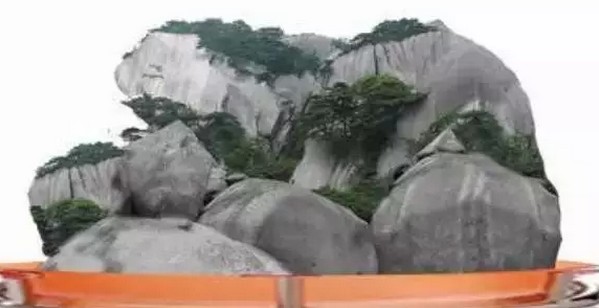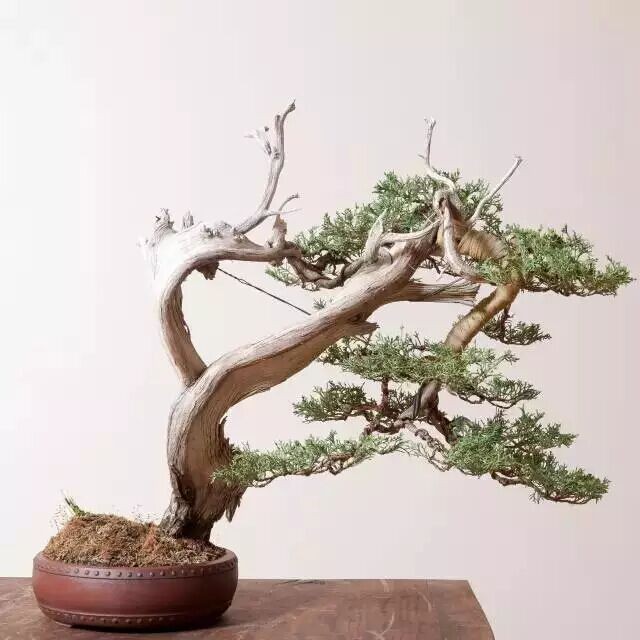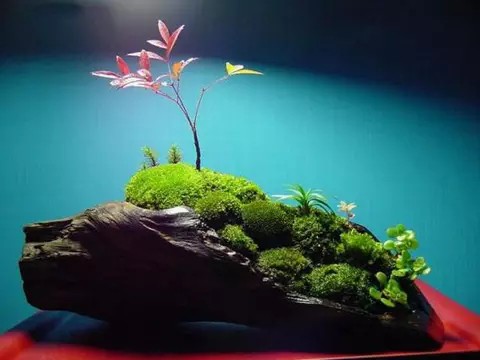Decoration and embellishment after the production of landscape bonsai
In the production of landscape bonsai, the theme is generally determined, the preliminary artistic conception is carried out, and then the materials such as pots, stone, plants and accessories are selected, and then the stone is processed and configured, and finally the plants and accessories are embellished.

The basin is the main component of bonsai, and it also plays an important role in viewing. Landscape bonsai includes three forms: water stone, dry stone and flood and drought, and there are also some differences in the basin. In addition, there are hanging wall bonsai. Water and stone bonsai all use a shallow basin that can store water, which can not only represent rivers, lakes and seas, but also make the plants on the rocks absorb water, and at the same time play a role in helping modeling. People call landscape bonsai as three-dimensional landscape painting. Pots are equivalent to drawing paper, and the layout of mountains, rocks and trees is like painting in a basin.
Rectangular and oval shapes are the most common and most suitable shapes of water basins. Rectangular basin is neat and generous, often used to show majestic tall and straight peaks; oval basin is soft and beautiful, often used to show beautiful and open scenery. In addition, there are square, round, boat-shaped, crabapple-shaped, long hexagonal and long octagonal and other styles, which can be selected according to different needs and preferences. The height of the basin is deep and shallow, and now very shallow basins are often used. The color of the basin is generally light, and the common ones are white, light blue, light green, light yellow and so on, which are all very beautiful. The selection should be determined according to the bonsai content and the color of the mountains and rocks, and should be able to reconcile and contrast. There are many kinds of texture of water basin, which can be divided into stone, porcelain, enamel, pottery and cement and so on.
Dry stone bonsai and flood and drought bonsai, because of the need to plant plants, so more use of dry pots, that is, pots with holes.
After the completion of the production of landscape bonsai, in order to make it more full of life and reality, it is very necessary to decorate and embellish it properly on the basin. The purpose of embellishment and embellishment is to make the landscape bonsai more poetic and the theme more distinct and prominent.
The method of decoration and embellishment is to achieve the artistic effect of dense trees and green trees and towering peaks by planting and dotting moss properly, and then, according to the need, equipped with small bridges, pagodas, pavilions, pavilions, characters, animals and other furnishings, thus enriching the content of the works and highlighting the theme of the works.
1. Auxiliary moss point Cui:
General root stone, strong water absorption, easy to grow moss; hard stone if placed in a damp and cool place for a long time, the lower part can also produce thin moss. From the place where the moss grows, there are more moss in the lower part of the mountain stone, less on the upper platform, less on the bright surface and more on the backlit surface; there is less moss on the ridge and more moss in the depression, which is the law of natural ecology. From front to back, when all covered, it lacks a sense of reality and has the natural beauty of damaging rocks.
You can scrape off the moss on the shady and humid mountain surface or on the corner of the wall and spread it directly on the rockery; you can also mash the collected moss into thin mud or rice soup and brush them on the rocks with a brush; you can also spray diluted liquid on the rocks, cover them with plastic bags, put them in a cool place with scattered light, and soon grow moss on the bonsai.
2. Plant configuration:
When configuring trees on landscape bonsai, we should choose tree species and ecological shape according to the needs of artistic conception. The tree species commonly used for planting are five-needle pine, small-leaf Luohan pine, June snow, melon seed yellow poplar, small-leaf elm, sparrow plum, lobular privet, and herbaceous plants such as asparagus, Cuiyun grass, catgrass, iron fern and Phoenix tail fern, which are good matching plants.
When configuring plants, we should pay special attention to the proportion of plants to rocks. Woody plants should be matched with larger rocks, while herbs should be matched with smaller rocks. According to the saying in Chinese painting: "Zhangshan, foot tree, Cunma, separate people", the plants are not too large, and the size and height of the plants planted should be consistent with the theme. The morphology of plants growing in different parts is also different due to the difference of ecological environment. It is appropriate to install clumpy trees on the downhill slopes, and the trunks are generally straight; the trunks of the trees along the mountain stream are tilted to the edge of the water; the trees growing on the cliffs have the posture of flying upside down; and the trees standing on the top of the mountain often have a flat-topped crown.
Therefore, when configuring plants, we should carefully examine the environment and parts, configure and shape according to the law of plant growth in the natural landscape, and must not do as we please, resulting in distortion. The shape of woody plants should be cultivated in advance, planted on rocks, the roots should not be too exposed, should be hidden and exposed, trees should be planted on the hillside of the main peak, the second peak or the foot of the mountain, or planted on the side or back of the rock, so that the trunk and branches and leaves protrude beyond the stone, in order to increase the sense of hierarchy and show more natural beauty.
The plants should be properly arranged, the trees should not be too dense, and the beauty of the peaks should be shown. When planted is planted, when concession is let, do not rob the host, disorderly, destroy the overall beauty of the landscape.
The method of planting plants is generally to carve out caves on the rocks, plant the roots with soil into the holes, and assist with moss, leaving no artificial traces. Some can be planted directly into the large cracks in the rocks. Like trees that grow naturally, they are magnificent.
3. Accessories embellishment:
Placement of accessories should not only pay attention to the location of accessories, but also pay attention to grasp the proportion of size, but also consider in line with the reality of life. Such as the performance of famous mountains and rivers of bonsai, accessories are generally used in garden buildings, such as pavilions, pavilions, towers, etc., to make it coordinate with the scenery.
The location of accessories should also be in line with the law of layout. Generally speaking, pagodas are located on the second peak, with pavilions and buildings on the hillside, pavilions near the water, bridges across streams and ditches, rafts on rapids beaches, boats on wide water surfaces, cattle and sheep on grasslands, houses in lush forests, and so on. As for the placement of characters, just according to the needs of the artistic conception of composition, we should not be rigid and must be just right.
A plate of landscape bonsai should not be embellished with too many accessories, otherwise it will appear bloated. In general, small and medium-sized landscape bonsai embellished with 2 or 3 pieces can be arranged at random, some hidden and some hidden. The color of the accessories should not be too bright, it should be coordinated with the mountains and trees, which can not only show the bright color of the accessories, but also be unified in the overall color. At present, there are many kinds of bonsai accessories, such as pottery, porcelain, stone, plastic and so on. when choosing accessories first, we should make repeated consideration, make more comparisons, and choose carefully, so that the accessories can really play the role of finishing touch.
Although the landscape bonsai can not be arranged and embellished rigidly according to the traditional proportion of "Zhangshan, ruler tree, inch horse, separate people", it cannot be exaggerated excessively, because only the low height of the trees and the small size of the pavilion can set off the majesty and height of the mountain, and show the reality and natural beauty of the landscape bonsai.
Time: 2019-06-04 Click:
- Prev

Sabina vulgaris (bonsai)-the only living fossil of plants
From ancient times to the present, the world does not hesitate to express its favor for pines and cypresses. In the Preface to Pines and cypresses, Bao Zhao of the Northern and Southern dynasties said: pines and cypresses were ordered to be alone, and the generations did not decline. Su Zhe in the Sansu Middle School of the Song Dynasty also wrote in his Fu Xu of Poria cocos: cold and summer cannot be changed, years cannot be defeated, but pines and cypresses are the case.
- Next

The method of "spot moss" of landscape bonsai
The mention of moss bonsai can not help but remind us of Japanese-style horticultural landscape, lovely shape, green bonsai by people's imagination to add different themes, a small container is a miniature small world. The advantage of making moss bonsai is to cultivate our carefulness and patience.
Related
- Fuxing push coffee new agricultural production and marketing class: lack of small-scale processing plants
- Jujube rice field leisure farm deep ploughing Yilan for five years to create a space for organic food and play
- Nongyu Farm-A trial of organic papaya for brave women with advanced technology
- Four points for attention in the prevention and control of diseases and insect pests of edible fungi
- How to add nutrient solution to Edible Fungi
- Is there any good way to control edible fungus mites?
- Open Inoculation Technology of Edible Fungi
- Is there any clever way to use fertilizer for edible fungus in winter?
- What agents are used to kill the pathogens of edible fungi in the mushroom shed?
- Rapid drying of Edible Fungi

